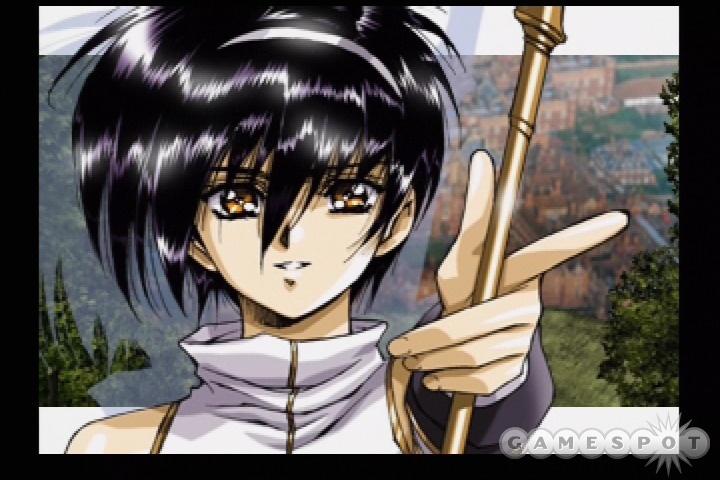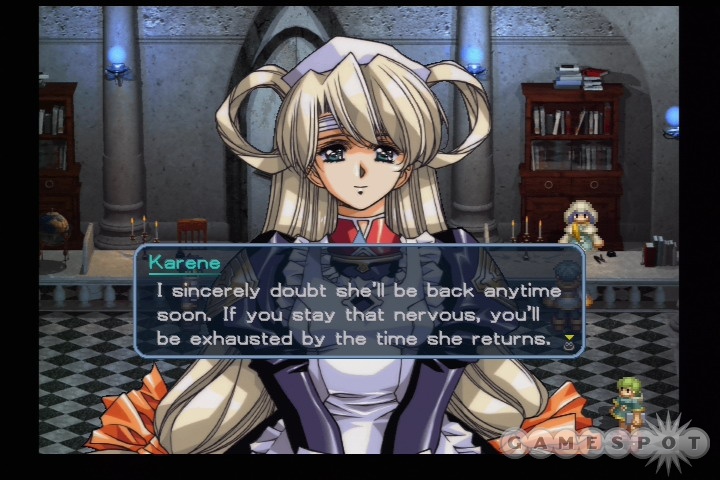When the folks at Working Designs take on a project, you can generally count on a few things--the localization work will be intense, the amount of fan-pleasing content will be high, and the release date will forever hover just out of grasp. Growlanser Generations, the company's latest endeavor, certainly suffered from its share of the latter, but it also benefits from a generous amount of the former. This package contains Career Soft's Growlanser II: The Sense of Justice and Growlanser III: The Dual Darkness, two full-length strategy role-playing games. While these 3-year-old RPGs are now a bit behind the graphical curve, they still offer lengthy branching storylines and lots of tactical action, making this a great package with tons of value.

Growlanser II introduces you to a spindly, doe-eyed youth named Wein Cruz, an aspiring knight who wishes to ascend to the highest rank of his order. Growlanser III revolves around Slayn, a young man with shaggy grey hair and a mysterious past he cannot seem to remember. In both games, you are fairly quickly joined on your adventures by a number of colorful characters who run the gamut of anime archetypes, but are engaging nonetheless. There are plenty of slender young men, grizzled swordsmen, weasel-faced villains, and adorable young ladies of various types (motherly, violent, or simply "cute"), but they all work together well in the context of their respective storylines. One of the more interesting things about the Growlanser games is that, depending on how you comport yourself during the game and what dialogue branches you choose or quests you take on, you can earn a myriad of different endings. In The Sense of Justice, the branching dialogue is fairly open, but in The Dual Darkness, you choose a blood type for your character that actually defines certain aspects of his personality, which will lock you out of some dialogue options. Fortunately, Working Designs thought to include a crazy blood-type guide in the manual, so you'll be able to plumb the mysteries of what having AB blood really says about a person.
The worlds in both games are large and sprawling, and you'll be hopping through various key locations in each with slightly different systems. In The Sense of Justice, you'll be presented with a world map with rails between locations, rather akin to the Final Fantasy Tactics system of movement. So to travel across the maps, you'll progress through set checkpoint locations. Sometimes, a random battle or a story event will be triggered as you pass through. Other times, you can choose to stop at a location and gather information, chatting with any NPCs who might be at that spot. Growlanser II doesn't force this kind of interaction upon you, but checking all the map locations tends to reveal side quests and dialogue options you wouldn't have had access to otherwise, so you'll find it worthwhile to check and recheck places for new interactions. Towns and such will also generally have inns where you can regain your magic points and status (health regenerates after battles in Growlanser II), as well as shops to visit. Growlanser III's world map is open to free-roaming movement, and the towns and cities can be entered and explored (whereas in the previous game, you get only dialogue menus). It takes a bit more of the traditional RPG "talk to everyone you see at least twice" approach to acquire and complete quests in Growlanser III, but there are still plenty to choose from.
So, there are lots of things to do to flesh out the world, but of course the core of the gameplay is focused on the Growlanser tactical battles and ring-based weapon system. Upon entering a battle, you'll be placed on a map with any party members you have to face your foes. The games don't operate on a grid-based system, instead giving your characters license to roam as they will over any accessible terrain. Since characters cannot physically pass through each other, you'll find that certain areas of certain maps create narrow passages that impede progress--you can use these to block enemy advancement while trying to avoid getting bottlenecked yourself. You can guide characters to specific locations with the move command, or you can order them to attack an enemy, which will cause them to walk up to and engage that monster. Other characters will attack with ranged weapons like bows and slingshots, and still others will have magic available to them. Magic use comes with a cast time--someone who is casting an "aria" for a magic spell cannot move, and that character's chanting can be interrupted by attacks, but he or she can chant spells up to greater levels of effect, and once the initial cast is done, it's a fairly simple matter to keep throwing out spells. In Growlanser III, you can gain the ability for characters to cast cooperatively to unleash even more-powerful spells. The available tactics afford the games a nice amount of depth, and there are also plenty of customization options for your characters.
Both games utilize the ring-based weapon system. Essentially, each character can equip a ring that, in turn, changes into a weapon that suits the nature of its user. The rings themselves will all carry different stat bonuses (and you'll earn lots of rings in battle, and better ones if you can end battles quickly), but that's not all. The rings then also have slots on them for gems, and gems can grant you new abilities or boost your stats. Each gem slot has a number value that restricts the type of gem you can place in that slot, so you'll have to plan all your mixing and matching across your various party members. As if that weren't enough, your characters will also earn points as they level up, and you can distribute those points into abilities for your characters like passive effects, new magic spells, and technique attacks. You get only a small number of these points at a time, and there are certain abilities you might later feel like you "wasted" points on, but otherwise the customization options give you a lot to work with, and let you refine your party members well.
These games were developed in 2001, and visually, they show it. Growlanser III has an edge on its predecessor, with some nicer set-piece environments in towns and cities, but both games sport some sprites and magic effects that are somewhat primitive by today's standards. Still, the attention that isn't evident in some of the blocky characters and washed-out maps blazes forth in the character art. Each character has a nearly full-figured avatar that will often pop up during voiced cutscenes, and this artwork is heavy in detail and larger than life (literally taking up the whole screen on occasion). The characters also go through some rudimentary animation during their speaking roles to further give these games their strong anime stamp. Overall, both games still manage to look good, despite the obvious pixelation in places.

There's more than 10 hours of recorded dialogue total for these two games, and the quality of it is fairly solid, with some mixed performances. There are a few strong voices that stand out with a lot of personality, but that's among a crowd of average parts with sometimes odd intonation. There are also times when different parts of a character's speech will sound like they were recorded in different sessions. But everything is earnestly delivered, and it's easy enough to skip the dialogue if you don't want to sit through it. The games' soundtracks serviceably provide themes without much standout music, complementing the experience while staying out of your way.
Fans of role-playing games rarely get as good a deal as this package offers--two full-length tactical RPGs with branching paths, numerous side quests, and tons of content for the price of a single game. The fact that these games have some years on them shouldn't deter fans from giving this package a try, as it features two great titles whose gameplay remains entertaining.